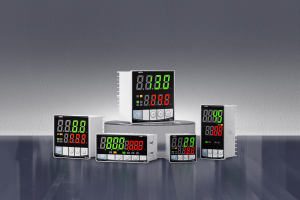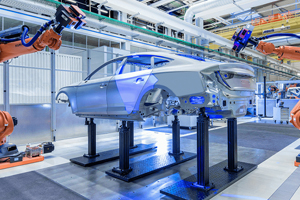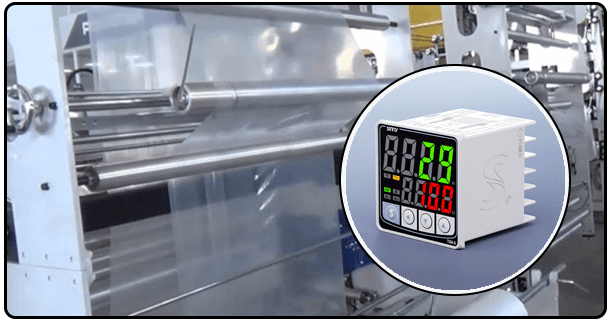Understanding Solid State Relays (SSRs)
Understanding Solid State Relays (SSRs)
Solid State Relay is an electronic switch which controls the distribution of electrical power without using mechanical contacts. SSRs are different from traditional mechanical relays because they use semiconductor technology to control electrical loads. This is usually done with components like MOSFETs or Triacs. SSRs are controlled by a control signal at low voltage. Employing SSRs in PID temperature controls systems has many advantages. The absence of contacts in SSRs eliminates the inherent problems associated with mechanical devices, including contact bounce, arc formation, and mechanical wear that eventually leads to failure. Second, because SSRs can switch at higher frequencies than mechanical relays they are ideal for PID applications which use Pulse Width Modulation for heating control. SSRs also contribute to the quieter performance of systems due to their silent operation. A lack of wearable mechanical components means that they have a longer lifespan. The SSR has become the most popular switching element for modern PID applications. This is especially true when fast switching, smooth controls, and long-term durability are required.
Two types of SSRs are commonly used for temperature control: MOSFET and Triac SSRs. Triac SSRs, which use the Triac device to control AC loads are designed for AC load controls. Although phase-control SSRs are available, they're less common for on/off controls that typically go with PID. AC or DC SSRs and Triac-based MOSFET SSRs are selected based on the requirements for the application. This includes the type of load (AC, DC, voltage and current levels), as well as the control signal characteristics. These primary benefits of SSRs for PID systems are a major factor in the choice of load switching elements. Contact bounce is prevented by removing mechanical contacts. This can interfere with sensitive signals produced by PID controllers, particularly during switching the SSR. SSRs have a fast switching ability, which allows the controller (via PWM, for example) to modulate them to control the temperature proportionally. This leads to smoother adjustments in temperature and less thermal cycling. Mechanical relays may have problems with PWM and cause unwanted noise, or even fail early. SSRs are also more reliable for longer-term projects due to their long lifespan. It is important to be
III. The Key Parameters to Selecting a SSR
The selection of an appropriate SSR has a direct impact on the reliability and performance of the PID system. To ensure safety and compatibility, it is important to carefully consider a number of key parameters. First, it is important to select the SSR based on load requirements. The SSR current rating must be high enough to incorporate a safety margin, and the voltage of the load (AC orDC) should match the SSR. SSR power ratings, which are calculated by multiplying Voltage and Current, should also be taken into consideration. It is important that the SSR can handle all power requirements of the load. The SSR also needs to be able to handle the PID controller's switching frequency. It is especially important when the system uses PWM to control the heating element proportionally. Microcontrollers that implement the PID algorithms must be operated at high frequencies to enable the SSR to operate properly. Verify that the SSR meets all requirements by checking the maximum switching frequency. Control signal requirements are also important. SSRs must match the output voltage levels of PID controllers (e.g. 3.3V or 5V). SSRs typically require an input voltage range that matches common logic levels. Check the SSR input voltage specification. Terminals such as Terminal 1 are usually used for the connection to control signals. Terminal 2 is a common terminal. If you want to ensure correct wiring, connect the PID's output to Terminal 1 using a transistor (or directly if it is safe), and terminal 2 to ground of the PID or another suitable reference. It is also necessary to verify the SSR input current requirement. The controller output pin should be able to source/sink this current. A transistor may be required if an SSR needs more current than can be safely provided by the controller. These requirements will be specified in the SSR's datasheet. Another important parameter is thermal management. For proper operation, most SSRs require external heat sinks. This is especially true for higher power SSRs. SSR datasheets provide thermal resistance and power dissipation (in degrees Celsius/watt). This information allows you to calculate temperature and choose the right heat sink. Material, mounting technique, size and other factors should be considered. The mounting options (surface mount, screw terminal) should match both the SSRs and heat sinks. It is important to have protection features such as OVP, UVP and SCS. For inductive loads SCS is recommended. Choose an SSR that has appropriate protection built in. Another important consideration is isolation. SSRs must have sufficient input/output isolation for noise and safety. It is important to consider the isolation voltage rating.
IV. Integration of the SSR and the PID controller
The next step is to integrate the SSR correctly with the controller. It is necessary to connect the PID controller output signal (which represents the error, and calculated corrective actions) with the SSR control input. The controller's control signal must be identified as sinking current or sourcing. The SSR's wiring is affected by this. SSR output should be wired to PID controller output, PID output to SSR control input (often Terminal 1 - low side connection), and SSR common terminal to ground of PID controller or suitable reference. The load (e.g. heating element or fan) must be connected between Terminal 2 (often the SSR Load terminal) and the connection point of the power supply for the load. For safety and reliability, ensure that the system and load are properly grounded. It is recommended to provide a clear and simplified wiring diagram that shows the connection between the SSR, PID controller, load and power supply. This diagram is required. It is easy to power the system. Connect the SSR control input to the SSR output, and then the power supply. The PID output may be initially set at a very low level in order to ensure that the SSR has been turned off. Check that the SSR is responding correctly. The initial test should verify that the wiring basics are functional. Check the output of the PID controller (e.g. using an oscilloscope, if one is available) and confirm that it drives the SSR correctly. Make sure the heat sinks are properly mounted and connected for efficient cooling.
V. PID tuning with SSRs: Considerations
SSR characteristics and the choice made can affect PID tuning. Control loop lag is caused by the thermal mass and heat sink of the SSR. SSR switching dynamics may not be instantaneous, despite being fast. This must be compensated for by the PID controller. Power delivery to the load is affected by voltage drops in SSRs. These factors may affect the response of the system and require changes to PID parameters. It is important to consider the impact of tuning. It is possible that the process gain will differ when compared to a pure resistive load. SSRs and heat sinks can introduce a time delay that affects the response. This may necessitate adjustments to Integral (I), and Derivative terms (D). Iterative tuning is used. Begin with Proportional. Tune the P term first, to get a good response and avoid excessive overshoot. Introduce the I-term to eliminate any steady state error and watch the behavior of the system. Keep an eye out for potential instability. Add D to dampen and stabilize, especially if you experience oscillations. Tuning can be an iterative procedure.
Safety is paramount when working with electrical components and AC power.Check all connections with the SSR wiring diagram and datasheet. Verify that the SSR has been correctly connected to the load. (AC/DC and polarity). To prevent loose or short connections, it is important to have secure connections. Check that the connections are all secure. Tests should be conducted with caution. When powering on the system, the output of the PID should be set at a very low level. Increase the control or setpoint signal gradually. Be sure to observe how the load behaves. Disconnect the electricity immediately if any problems arise.
- Temperature Control Using PID Controller: Circuit Diagram & Explanation
- Article about Temperature Control with a PID Controller






















